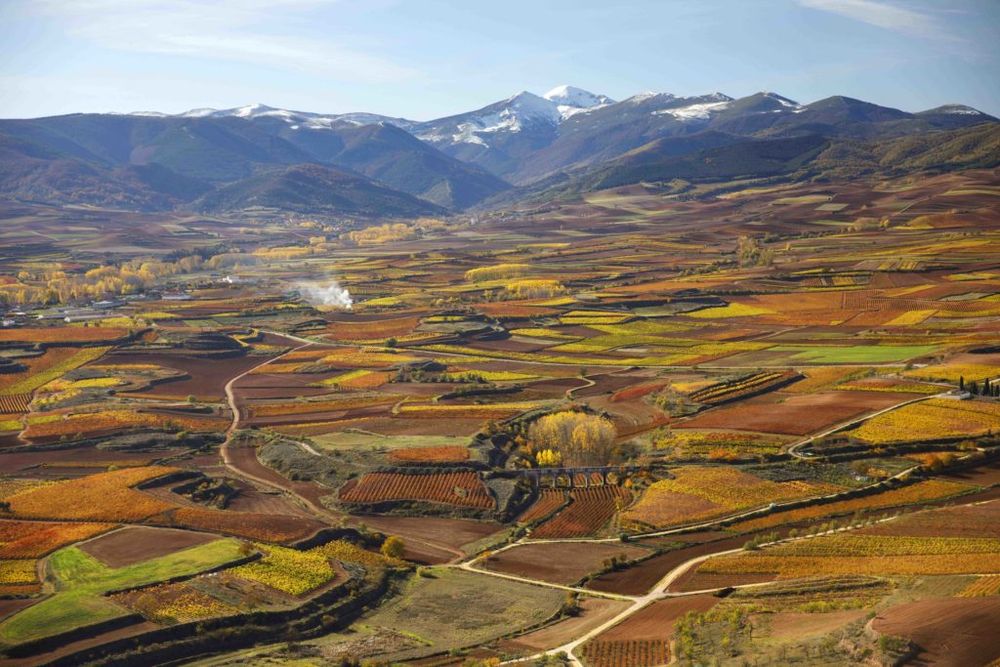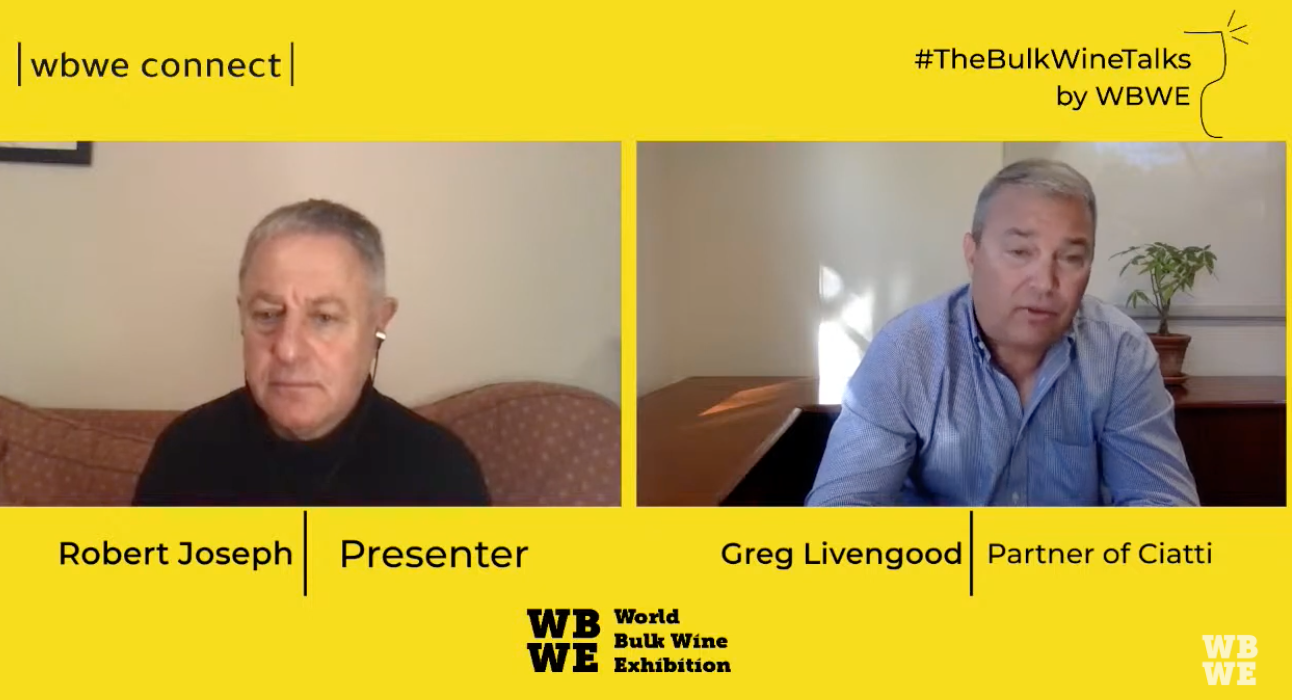Keeping the US wine and bulk market moving forward in a post-Covid economic landscape will be inevitably complex, but Ciatti’s Greg Livengood is full of fighting talk.
(You can watch the full interview between Robert Joseph and Ciatti’s Greg Livengood covering the topic: ‘Why the US is a major importer and exporter of bulk wine’ here. It is part of series Joseph is presenting during ‘WBWE Connect’, the virtual edition of the World Bulk Wine Exhibition that is usually held at this time of the year in Amsterdam. You can watch other videos in the series including an interview with Bernard Fontannaz of Origin Wine here. And for upcoming interviews click here).
For those who spend most of their working days fretting about the fortunes of the premium wine market, then the world of bulk wine might seem a long way away. But think again. Yes, a large part f the bulk market is all about shipping volume wines to hit price points in key markets around the world. It was what, Ciatti’s Greg Livengood, says drives cash flow for so many producers at the value end of the market.
In California so much of this wine comes from the San Joaquin Valley, part of the Central Valley, and goes into products that live their lives on the bottom-shelf of major retail stores. But there’s also a huge, and growing premium trade, too, particularly in the US.
Some top wineries, explains Livengood, can sell off up to 20% of their surplus grapes for bulk wine because they don’t quite make the quality cut for their brand. It means, adds Livengood, there is currently significant trade for premium Napa Cabernet Sauvignon, that trades at up to US$10-15 per litre. Interested now?
The bulk wine landscape in 2020
Before we can start analysing the impact of Covid-19 on the bulk wine market and the overall picture in 2020, we need to put in context to the challenges the market, particularly in the US, was facing in 2019, says Livengood.
A major shift in US drinking trends had seen consumers move in their droves away from their traditional choices, mainly wine, towards ‘healthier’ products like the hard seltzer. Wine consumers, in turn, were turning towards buying better quality wines in smaller quantities. Both of which went put together took its toll on the traditional US bulk market.

Sales of hard seltzers driven by major brands like White Claw have had a big hit on the US wine market
On top of these shifts in consumer habits, lots of US producers were also suffered from import tariffs and the US’s loss of business with China. Then there was the huge surplus left after the bumper crop of 2018, which the already-saturated market wasn’t looking to buy.
“It was tough,” said Livengood, “It was very very tough. The future of the wine business in the US was in doubt from a growth potential. We were looking at how to stem the losses rather than figuring out how to grow the industry. Things are much, much different today.”
Lockdown turnaround
Lockdown was a help to the bulk wine industry via the off-trade, as consumers accustomed to drinking top-quality wine in the on-trade were forced to drink shop-bought wine at home. But Robert Selby, editor of Ciatti’s Global Market Report, prefaced this year’s edition with a caution on the longevity of lockdown habits.
He said: “While off-trade wine sales have been strong in many markets since Covid-19 went global in March, to the special benefit of the big brands with national/international distribution at supermarkets, it remains to be seen if this will be sustained, especially as the economic consequences of Covid-19 measures could start to be felt more keenly by consumers in 2021.
“Hopefully if wine sales in supermarkets fall back again it will be for a positive reason – the rolling out of an effective vaccine, permitting consumer habits to gradually return to normal.”
Impact of fires

The charred remains of one of the many damaged homes at Silverado Country Club. Picture: Napa Valley Register via ZUMA Wire)
Another huge influence on the bulk market this year has been the Californian wild fires, the biggest in the state’s history, that hit just before its grape harvest. For Californian winegrowers this posed huge problems, particularly around the loss of crop due to smoke taint.
Many producers chose to reduce the size of the crop they picked for the 2020 harvest and, especially in premium areas, cut their losses early with smoke-tainted grapes. Instead, they bought large quantities of previous-vintage bulk wine from 2018 and 2019 to blend.
“They essentially cleaned out the market,” said Livengood. “You had all this excess wine sitting there with nowhere to go, and it all got blown out of the market in a relatively short period of time.”
All of which has helped to balance out the Californian bulk wine market as the decreased 2020 crop has seen prices rise, and the huge excess of 2018 inventory that had been depressing the market for the last couple of years has now largely been sold. This, though, is no solace to the number of growers that were forced to reduce the size of their harvest at a considerable financial loss.
Moving forward Livengood predicts grape prices will remain in line with the last decade’s averages, but said the future will be “challenging on all fronts”.
Changing global markets
No bulk wine market operates in isolation and whatever is happening in the other key global bulk markets, will impact the conditions in your country too, said Livengood, who stressed changes in bulk wine trends are often the results of short-term convenience rather than longer-term trends.
He points to South Africa as being a case in point. It was able to benefit enormously in the US in the early 2010s on the back of the earthquake in Chile, when its supplies were badly hit. This opened the door for South Africa, particularly in areas such as Chardonnay, but this was very much market driven vs a sudden US consumer demand for South African specific white wines.

Bulk wines from Spain have the potential to do well in the US says Ciatti’s Greg Livengood
One place in which Livengood sees a lot of potential for growth in America is Spain. This is largely due to the country’s large-scale organic production. “The organic wine that comes out of Spain is priced at a level that works here. We haven’t had a tremendous amount of success yet but we do think that over time that is a nice opportunity for Spain,” he told Joseph.
‘Clean’ and celebrity wines
The celebrity wine boom of recent years has been difficult to ignore. Each week it seems a new celebrity has paired with a large wine producer to put their name – and sometimes their taste buds too – to a brand. Back in the summer Snoop Dogg joined the list, staring out from the famous talking labels of 19 Wines. For Livengood, anything that promotes wine is a good thing for business.
Alongside celebrity wine there has also been growth in the market for ‘clean’ wine after Cameron Diaz’s launch of Avaline, a brand that claims to be “Transparently produced, full of natural goodness, free of unnecessary extras”.
For Livengood clean wine feels like the wine industry’s answer to the hard seltzer, whose customer base is interested in knowing every calorie that sits in their glass. With wine there isn’t a lot of this kind of information on the bottle so the proclamations of transparency with clean wine are enticing. “This is a way of reaching that segment, and it seems to be popular and successful,” he said.
Impact of the US Election
And finally, does Livengood see a change for the bulk wine industry with the (almost) new administration? He is positive but doesn’t see immediate change on the horizon. “The biggest change for the wine industry over the last four years was the addition of all these tariffs. That’s been significant for those on the origin end and for importers here. It’s been difficult. I don’t foresee any new tariffs. Longer term you will probably see some of these tariffs lowered or going away. In the mean time you can still ship bulk wine here and not pay those tariffs! It’s not so helpful for Burgundy, but there are alternatives for bulk.”
- You can find all past and upcoming talks hosted by Robert Joseph during WBWE Connect here.
- Producers and buyers can take part in WBWE Connect to network and do business online as part of the WBWE’s new digital platform. It is available to do business until December 4. Full details here.









































